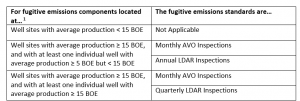Pennsylvania’s Oil and Gas RACT Rule Finalized
Posted: May 3rd, 2022
Authors: Christine C.
UPDATE: On May 4, 2022, PADEP withdrew the Pennsylvania Oil and Gas RACT Rule from consideration for final approval by the Independent Regulatory Review Commission, which was scheduled to vote on May 19, 2022. The rule will undergo further legislative review, which was triggered by a disapproval of the proposed final rulemaking from the House Environmental Resources and Energy Committee. The re-evaluation of the Pennsylvania Oil and Gas RACT Rule will likely extend into the end of the year which means we may not see a final rule until 2023.
On March 15, 2022, the Pennsylvania Department of Environmental Protection (PADEP) presented the final version of the proposed Reasonably Available Control Technology (RACT) rule for the control of volatile organic compound (VOC) emissions from oil and natural gas sources in Pennsylvania, commonly referred to as the control techniques guidelines (CTG) RACT Rule, to the Pennsylvania Environmental Quality Board (EQB). The EQB voted to approve publication of the rule as a final-form rulemaking in the Pennsylvania Bulletin but it has not yet been published. The CTG RACT Rule will be promulgated as 25 Pa. Code §§129.121 – 129.130 and will regulate VOC emissions that are associated with existing oil and gas operations in Pennsylvania. The final rule will also “…take effect immediately upon publication in the Pennsylvania Bulletin.”
See ALL4’s previous article regarding the then-proposed CTG RACT Rule when it was published in draft form back in 2020 for a more detailed rule review. There are several notable revisions to the draft rule based on public comments received during the public comment period. Several important changes to the final CTG RACT Rule that will most likely impact the oil and gas industry in Pennsylvania are identified and discussed below.
Storage Vessels:
The draft CTG RACT Rule included an exemption from storage vessel control requirements for storage vessels with potential VOC emissions of less than 6 tons per year (tpy) at conventional well sites and older unconventional well sites (installed prior to August 10, 2013). That proposed exemption level has been removed, and now storage vessel requirements apply to all storage vessels with potential VOC emissions of greater than 2.7 tpy. To qualify for an exemption, owners/operators must keep records, starting 30 days after the rule is final in the Pennsylvania Bulletin (i.e., likely starting in May or June 2022), demonstrating that actual VOC emissions are less than 2.7 tpy from each storage vessel.
Natural Gas-Driven Pneumatic Controllers:
PADEP has clarified the rule to clearly state that the requirements for pneumatic controllers apply only to continuous bleed pneumatic controllers. Intermittent bleed controllers are exempt from the rule. All continuous bleed pneumatic controllers must meet the following:
- ≤6.0 standard cubic feet per hour (SCFH) if located at any affected location that is not a natural gas processing plant (e.g., at well sites).
- Zero SCFH if located at a natural gas processing plant.
Natural Gas-Driven Diaphragm Pumps:
There were no substantial changes to the requirements for diaphragm pumps. The changes to the rule for natural gas-driven diaphragm pumps are largely clerical and language changes for clarity. The standard for affected natural gas-driven diaphragm pumps requires VOC emissions reduction by 95.0% by weight or greater.
Compressors:
The proposed rule exempted reciprocating compressors located at well sites from the rule. PADEP has removed this exemption from the final rule. All affected reciprocating compressors, including those located at well sites, must undergo rod packing replacements on or before the reciprocating compressor has operated for 26,000 hours or every 36 months. The requirements for centrifugal compressors have not changed.
Fugitive Emissions Components:
Probably the most controversial rule provisions, and the most likely provisions to adversely impact the conventional oil and gas community in Pennsylvania, are the requirements for fugitive emissions components. In general, the fugitive emissions components provisions require periodic leak detection and repair (LDAR) surveys and more frequent audio, visual, and olfactory (AVO) inspections. PADEP has provided additional time for affected owners/operators to conduct initial AVO inspections, which will now be due 60 days after the rule is published in the Pennsylvania Bulletin (likely in June or July 2022).
PADEP has revised the blanket exemption for “low producing” well sites [i.e., those producing an average of less than 15 barrels of oil equivalent (BOE) per day]. PADEP has included the following tiered requirements for fugitive emissions components at well sites, which incorporates considerations for individual well production rates:
1 The recordkeeping requirements for oil wells with gas-to-oil ratio (GOR) less than 300 SCFH has not changed. In addition, the monthly AVO inspection and quarterly LDAR inspection requirements for natural gas gathering and boosting stations and natural gas processing plants also have not changed.
PADEP has added language describing how the daily average production rate should be calculated; notably, the calculation is to be based on monthly data averaged over 12-months (i.e., owners/operators will not have to figure out their daily throughput). Average BOE calculations must be made annually by February 15th for the previous calendar year and based on those annual production calculations, PADEP has provided options for changing LDAR survey frequency if the well site falls into a new category. There is also no longer a “step-down” option to allow for reduced LDAR survey frequency based on the percent of fugitive emissions components found to be leaking.
Well sites with average production ≥ 15 BOE, and with at least one individual well with average production ≥ 5 BOE but < 15 BOE now have the option of submitting a case-by-case petition to request exemption from the annual LDAR survey requirements if the owner/operator can show it is not technically or economically feasible to do so. It is not clear what the expectation for timing is for submittal and approval of such exemption requests, but it appears that owners/operators must comply with the LDAR frequency required by the rule until PADEP grants the exemption.
Other Changes:
While not entirely impactful, there were several other changes to the final rule, including:
- Administrative corrections and language streamlining.
- Clarifications made to certain definitions.
- Additional time provided for reoccurring compliance deadlines (e.g., number of days allowed between monthly and quarterly compliance obligations, number of days allowed for performance testing of existing control devices).
- Updates to recordkeeping requirements based on revised standards for storage vessels, pneumatic devices, and fugitive emissions components.
Other Items of Note:
Arguably the most repeated comment provided by representatives of the oil and gas industry in Pennsylvania was that PADEP failed to distinguish conventional from unconventional oil and natural gas operations in the proposed rulemaking, consistent with Act 52 of 2016. In response, PADEP noted that Act 52 applies to rulemakings promulgated under Title 58 of the Pennsylvania Consolidated Statutes (Pa.C.S.) and, since this final-form rulemaking is being promulgated under the Air Pollution Control Act (APCA) in Title 35 Pa.C.S., the requirements in Act 52 do not apply to this action. Based on the final rule, conventional well sites, which have been historically exempt from nearly all oil and gas regulations and permitting requirements in Pennsylvania, are now subject to the CTG RACT rulemaking. Affected facilities in Pennsylvania will also need to watch the development of proposed 40 CFR Part 60, Subpart OOOOc (proposed in November of 2021) which, when final, will establish emissions guidelines to aid states in the development of standards to regulate VOC and greenhouse gas emissions for existing oil and gas operations. While the requirements of the CTG RACT Rule and the proposed Subpart OOOOc will likely overlap, the CTG RACT Rule will need to be at least as stringent as the final version of Subpart OOOOc.
The clock will start ticking as soon as this rule shows up in the Pennsylvania Bulletin. Within a month or two, affected owners/operators must start AVO inspections and recordkeeping for storage tanks. If you have not done so already, an inventory of all potentially affected equipment as well as a comprehensive applicability determination should be made as soon as possible. If you have questions about how the Pennsylvania CTG RACT Rule or other air quality regulations may apply to your facility, please reach out to me at cchinofsky@all4inc.com or 610-422-1155.


